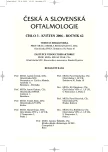Visual Functions’ Detailed Evaluating in Patients with Sjögren’s Syndrome before and after Intracanalicular Implants’ (Smart Plug) Insertion – (First Results)
Authors:
D. Hejcmanová; I. Němcová; R. Slezák 1
Authors‘ workplace:
Oční klinika FN, Hradec Králové
přednosta prof. MUDr. Pavel Rozsíval, CSc.
; Stomatologická klinika FN, Hradec Králové
přednosta doc. MUDr. Věra Hubková, CSc.
1
Published in:
Čes. a slov. Oftal., 62, 2006, No. 3, p. 183-189
Overview
The aim of the study was to determine exact visual functions (log MAR [minimal angle of resolution] and CS [contrast sensitivity]) and to evaluate corneal topographic maps in patients with established (by means of laboratory and biopsy examinations) Sjögren’s Syndrome, and to determine the difference in subjective symptoms before and after insertion of the intracanalicular implants as well.
Patients and methods:
Twelve eyes (1 man, 6 women) with established Sjögren’s syndrome were examined before and during two months after the insertion of the plugs. The best-corrected visual acuity (BCVA) was assessed on Landolt C rings optotypes. CS was measured on computer-controlled device (Neuroscientific Corp., U.S.A.) in 6 space-frequencies (0.74–29.55 c/deg). The corneal topographic changes (Keraton Opticon) were established by means of comparing total aberrations values before and after the intracanalicular implants’ (Smart Plugs type) insertion. The control group for visual functions assessment consisted of 10 woman (20 eyes) of similar middle age.
Results:
The BCVA on log MAR optotypes was 0.84 (0.69–0.95) before and 0.88 (0.52–1.23) after the insertion, on both occasions, it was lower than in the control group. The CS was before the insertion in all of the spatial frequencies lower, the largest differences were in the frequencies range 1.97–7.29 c/deg (p < 0.01). After the treatment, the values grow but they don’t reach the values of the control group. Subjective complains of the patients decreased markedly; in 100 % they had relief, in 3 cases they referred improvement up to 50 %; no patient observed tearing. The frequency of drops’ application has decreased by 63 %. The Schirmer test, in 100 % positive before the treatment, was after the insertion in 75 % negative; the height of the tear-meniscus was positive in 100 % before the procedure, and after that, its measurement improved to 1 mm in 91 %; in 9 % it was 1.5 mm. We also noticed changes of the ocular surface by means of lissamine green staining; this test was before the procedure positive in 100 %, the improvement after that was in 63 %.
The regularity of the corneal surface is the determining factor of visual functions in “dry eyes”. The measurement of the corneal topography is useful in differential diagnosis and helps to distinguish mild and more serious conditions of dry eye. The improvement of BCVA and CS values after insertion corresponds with patients’ subjective evaluating. The best value of the treatment is improvement of the patients’ comfort; furthermore, after insertion of the permanent plugs they feel pronounced subjective relief and lowering of the frequency of drops application.
Key words:
Sjögren’s syndrome, contrast sensitivity, intracanalicular lacrimal plugs
Labels
OphthalmologyArticle was published in
Czech and Slovak Ophthalmology

2006 Issue 3
Most read in this issue
- Sympathetic Ophthalmia
- The Intravitreal Application of Triamcinolone in the Treatment of the Macular Edema
- Transpupillary Thermotherapy in the Treatment of Choroidal New Vessels in Age-Related Macular Degeneration – One Year’s Results
- Macular Area with the Glaucoma Patients
